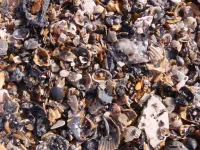Xerces Blue butterfly genome sequenced, an icon of anthropogenic extinction
The study, led by researchers from the Institute of Evolutionary Biology (IBE, CSIC-UPF), and the Museum of Natural Sciences in Barcelona, has succeeded in sequencing the complete genome of the Xerces Blue butterfly, the first butterfly to become extinct
2023-07-11
(Press-News.org)
The Xerces Blue butterfly (Glaucopsyche xerces) was native to the coastal dunes of San Francisco, in the United States. As the city grew, much of the butterfly’s habitat was destroyed and its population was relegated to Golden Gate National Park. Its wings were a deep iridescent blue, with characteristic white spots on the ventral side. The last surviving specimens of the species were found in 1941, by entomologist W. Harry Lange. It is considered the first insect species to have become extinct in historical times. Its disappearance has made it a global icon of anthropogenic extinction, to the extent that it has given its name to a famous American conservation association, the Xerces Society.
A previous study, in 2022, recovered mitochondrial DNA from a specimen of the Xerces Blue butterfly and compared it to that of the Silvery Blue butterfly (Glaucopsyche lygdamus), its closest living relative, concluding that they were indeed distinct species and not just different populations.
The research, led by Carles Lalueza-Fox, director of the MCNB and researcher at the IBE (CSIC-UPF), and Roger Vila, researcher at the IBE (CSIC-UPF), with the participation of Tomàs Marquès-Bonet, ICREA researcher at the Department of Medicine and Sciences of Life (MELIS) of the Pompeu Fabra University and the IBE and Professor of the same university, and published in eLife, has successfully sequenced the genomes of four Xerces Blue butterflies and seven Silvery Blue butterflies between 80 and 100 years old from the Smithsonian Institution in Washington. Researchers have been able to infer that the two species diverged between one and two million years ago and that they represent two distinct evolutionary lineages.
A comparison of the genomes of the two species revealed that the DNA of the Xerces Blue butterfly showed a high incidence of inbreeding, a sign of population decline that could be used to identify other insect species threatened by human activity and whose extinction patterns, unlike those of vertebrates, are currently not well known. It could also pave the way towards the de-extinction of this popular butterfly, a project that has been of interest to the scientific community for many years.
The Xerces Blue genome reveals its extinction story
The research results indicate that the Xerces Blue butterfly experienced a major population decline over tens of thousands of years, probably brought about by climate changes that did not affect the Silvery Blue. The destruction of its habitat by humans, however, triggered its eventual extinction.
This is the conclusion of the study after finding traits in its genome that are typical of a small population, including low genetic diversity, long chromosomal fragments with no genetic variation and a high frequency of deleterious alleles, which impaired the viability of individuals and made it what we would now term a vulnerable species.
Genomic clues could save other endangered insects
The Xerces Blue butterfly is an icon of insect extinction across the globe. Now its genome could help prevent the extinction of other endangered insects whose steep population declines are not immediately obvious.
"Detecting endangered mammalian species is easier, because in many cases it is possible to count individuals", explains Roger Vila, the IBE researcher (CSIC-UPF) who co-led the research. "However, there are many endangered insects whose status goes unnoticed because it is extremely difficult to census their populations, which generally seem to us to be very abundant. Nevertheless, they can be very sensitive to climate variations and human action, for example, to pesticides. For this reason, we believe that the genomic traits signalling the decline of the Xerces butterfly population could serve as a warning, and help us to detect vulnerable insects in future studies."
Knowing the whole genome is the first step towards de-extinction
The disappearance of insects, especially pollinators, is a very serious global ecological problem. The de-extinction of species such as the Xerces Blue butterfly, using genetic engineering techniques based on CRISPR, is therefore of enormous interest to the scientific community.
"The Xerces Blue butterfly is an excellent candidate for de-extinction because it is an insect that disappeared relatively recently, so the ecological impact of its reappearance is reduced, and there is no risk of pests or excessive proliferation due to the limited time of appearance of the adults (between March and April) and their ecological specialisation. We therefore hope that having its complete genome may help in future de-extinction initiatives", indicates Carles Lalueza-Fox, an IBE (CSIC-UPF) researcher and director of the Natural Sciences Museum in Barcelona, who co-led the study.
END
ELSE PRESS RELEASES FROM THIS DATE:
2023-07-11
Washington, D.C. – Bacteria found in 74 kitchens spread among 5 European countries were mostly harmless according to new research published in Applied and Environmental Microbiology, a journal of the American Society for Microbiology.
“We have previously found considerable variations in kitchen standards, food preparation practices, and cleaning regimes between France, Norway, Portugal, Romania, and Hungary,” said Birgitte Moen, Ph.D., Scientist—Department of Food Safety and Quality, Nofima—Norwegian Institute of Food, Fisheries, and Aquaculture Research, Ås, Norway.
In ...
2023-07-11
The aim is to maximize impact by turning to the combined talent and insight of the broader international neuroscience community.
SEATTLE — July 11, 2023 — Today, scientists from the Allen Institute for Neural Dynamics, a division of the Allen Institute, launched the world’s first completely open- and crowd-sourced neuroscience experiment—inviting researchers from around the world to publicly design a shared experiment that will run on the Allen Brain Observatory, as part of the Institute’s OpenScope program. Experiments will probe ...
2023-07-11
Biologists attempting to conserve and restore denuded environments are limited by their scant knowledge of what those environments looked like before the arrival of humans. This is especially true of coastal ecosystems, many of which had already been drastically altered by pollution and overharvesting hundreds of years before scientists began monitoring them.
According to a new study published in the journal PeerJ, a faithful analogue of modern marine ecosystems lies just beneath the surface. Building on more than 20 years of conservation paleobiology, the results suggest that fossils of various marine groups — including worms, mollusks, crabs and sea urchins — are ...
2023-07-11
Click here to watch a video on the new Cath Lab
Mount Sinai Queens today announced the opening of a new cardiac catheterization lab that will provide rapid and comprehensive care to hundreds of heart patients every year for life-threatening emergencies and scheduled cardiac procedures. The first cardiac catheterization lab in Astoria, it will transform treatment for patients in the growing communities of western Queens by vastly improving access to cardiac care in the borough and beyond.
Atul Kukar, DO, has been named the Director of the Mount Sinai Queens Catheterization Lab and leads a team of 14 specialists including interventional cardiologists, nurses, and technicians.
“Our ...
2023-07-11
There is a “silent hazard” lurking underneath our major global cities, and our buildings were not designed to handle it.
A new Northwestern University study has, for the first time, linked underground climate change to the shifting ground beneath urban areas. As the ground heats up, it also deforms. This phenomenon causes building foundations and the surrounding ground to move excessively (due to expansions and contractions) and even crack, which ultimately affects structures’ long-term operational performance and durability. Researchers also report that past building damage ...
2023-07-11
A team led by the Hong Kong University of Science and Technology (HKUST) has developed a technique to study how different fish species interact with each other in a coastal region, a breakthrough that helps explain the complex relationships among marine species and how global warming impacts fish populations.
By analyzing minute traces of fish DNA from samples of seawater, the team combined the use of environmental DNA – known as eDNA – and advanced statistical analysis to not only detect ...
2023-07-11
Motor learning skills let us move through the world: we use them to teach ourselves how to walk, how to pick up a drink, how to run. But age or sickness can weaken our ability to learn motor tasks. Scientists studying the impact of oxygen supplementation on motor learning have found a promising treatment that could help patients who have experienced neurological trauma recover old skills.
“A simple and easy to administer treatment with 100% oxygen can drastically improve human motor learning processes,” said Dr Marc Dalecki, now at the German University of Health and Sports in Berlin, senior author of the study in Frontiers in Neuroscience.
Repurposing ...
2023-07-11
A three-dimensional (3D) bioprinting technology capable of eliminating cancer cells using the function of immune cells has been developed for the first time in the world.
Through joint research with the Korea Institute of Machinery and Materials (President Sang Jin Park, hereinafter referred to as KIMM), the Korea Research Institute of Bioscience and Biotechnology (President Jang Seong Kim, hereinafter referred to as KRIBB), institute under the jurisdiction of the Ministry of Science and ICT, developed a 3D bioprinting technology using natural killer cells (NK cells)* as a new method of immunotherapy for treating cancer, and ...
2023-07-11
CHAMPAIGN, Ill. — According to two psychologists who study memory and perception, fraudsters tend to exploit the common habits of thought and decision-making that make us susceptible – and often oblivious – to their fabrications. Their book, “Nobody’s Fool: Why We Get Taken In and What We Can Do About It,” gives readers an overview of dozens of types of scams, hoaxes and strategies used by cheaters to deceive, and explains how to evaluate their ploys and avoid becoming a victim.
The authors, Daniel Simons, a professor of psychology at the University ...
2023-07-11
ARLINGTON, Va. (July 11, 2023) — Five medical societies have published a set of recommendations for operationalizing strategies for infection prevention in acute care settings that account for conditions within the facility, including the culture and communications style of teams, hospital policies, resources available, leadership support and staff buy-in.
“There is no best way to implement a practice, but implementation need not be overly complex,” said Joshua Schaffzin, MD, a pediatric infectious disease physician and a senior author of Implementing Strategies to Prevent ...
LAST 30 PRESS RELEASES:
[Press-News.org] Xerces Blue butterfly genome sequenced, an icon of anthropogenic extinction
The study, led by researchers from the Institute of Evolutionary Biology (IBE, CSIC-UPF), and the Museum of Natural Sciences in Barcelona, has succeeded in sequencing the complete genome of the Xerces Blue butterfly, the first butterfly to become extinct





